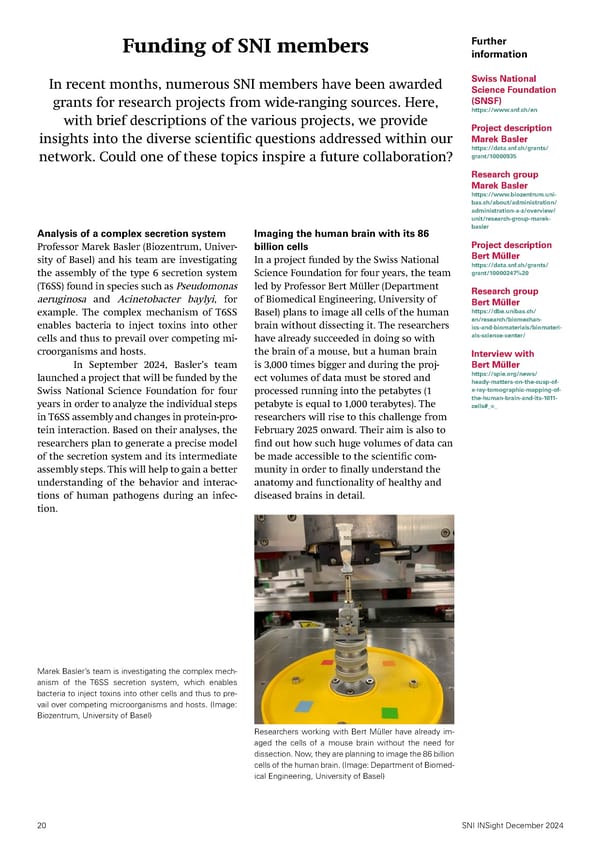Funding of SNI members Further information In recent months, numerous SNI members have been awarded Swiss National Science Foundation grants for research projects from wide-ranging sources. Here, (SNSF) https://www.snf.ch/en with brief descriptions of the various projects, we provide Project description insights into the diverse scienti昀椀c questions addressed within our Marek Basler https://data.snf.ch/grants/ network. Could one of these topics inspire a future collaboration? grant/10000935 Research group Marek Basler https://www.biozentrum.uni- bas.ch/about/administration/ administration-a-z/overview/ unit/research-group-marek- Analysis of a complex secretion system Imaging the human brain with its 86 basler Professor Marek Basler (Biozentrum, Univer- billion cells Project description sity of Basel) and his team are investigating In a project funded by the Swiss National Bert Müller https://data.snf.ch/grants/ the assembly of the type 6 secretion system Science Foundation for four years, the team grant/10000247%20 (T6SS) found in species such as Pseudomonas led by Professor Bert Müller (Department Research group aeruginosa and Acinetobacter baylyi, for of Biomedical Engineering, University of Bert Müller example. The complex mechanism of T6SS Basel) plans to image all cells of the human https://dbe.unibas.ch/ enables bacteria to inject toxins into other brain without dissecting it. The researchers en/research/biomechan- ics-and-biomaterials/biomateri- cells and thus to prevail over competing mi- have already succeeded in doing so with als-science-center/ croorganisms and hosts. the brain of a mouse, but a human brain Interview with In September 2024, Basler’s team is 3,000 times bigger and during the proj- Bert Müller launched a project that will be funded by the ect volumes of data must be stored and https://spie.org/news/ heady-matters-on-the-cusp-of- Swiss National Science Foundation for four processed running into the petabytes (1 x-ray-tomographic-mapping-of- years in order to analyze the individual steps petabyte is equal to 1,000 terabytes). The the-human-brain-and-its-1011- cells#_=_ in T6SS assembly and changes in protein-pro- researchers will rise to this challenge from tein interaction. Based on their analyses, the February 2025 onward. Their aim is also to researchers plan to generate a precise model 昀椀nd out how such huge volumes of data can of the secretion system and its intermediate be made accessible to the scienti昀椀c com- assembly steps. This will help to gain a better munity in order to 昀椀nally understand the understanding of the behavior and interac- anatomy and functionality of healthy and tions of human pathogens during an infec- diseased brains in detail. tion. Marek Basler’s team is investigating the complex mech- anism of the T6SS secretion system, which enables bacteria to inject toxins into other cells and thus to pre- vail over competing microorganisms and hosts. (Image: Biozentrum, University of Basel) Researchers working with Bert Müller have already im- aged the cells of a mouse brain without the need for dissection. Now, they are planning to image the 86 billion cells of the human brain. (Image: Department of Biomed- ical Engineering, University of Basel) 20 SNI INSight December 2024
 SNI INSight December 2024 Page 19 Page 21
SNI INSight December 2024 Page 19 Page 21